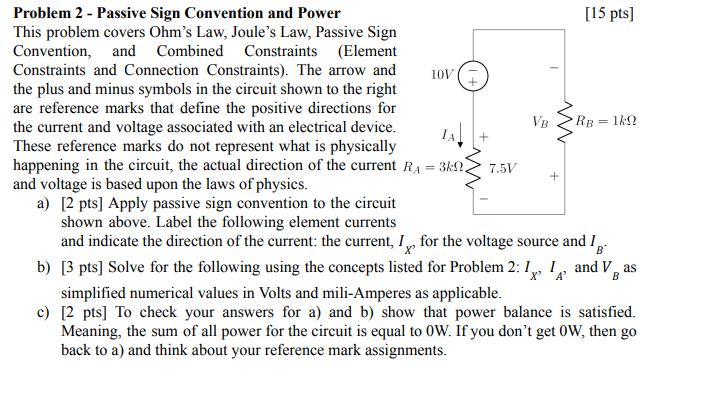Home /
Expert Answers /
Electrical Engineering /
problem-2-passive-sign-convention-and-power-this-problem-covers-ohm-39-s-law-joule-39-s-law-passive-pa892
(Solved): Problem 2 - Passive Sign Convention and Power This problem covers Ohm's Law, Joule's Law, Passive ...
Problem 2 - Passive Sign Convention and Power This problem covers Ohm's Law, Joule's Law, Passive Sign Convention, and Combined Constraints (Element Constraints and Connection Constraints). The arrow and the plus and minus symbols in the circuit shown to the right are reference marks that define the positive directions for the current and voltage associated with an electrical device. These reference marks do not represent what is physically happening in the circuit, the actual direction of the current 1 and voltage is based upon the laws of physics. a) [2 pts] Apply passive sign convention to the circuit shown above. Label the following element currents and indicate the direction of the current: the current, \( I_{X} \), for the voltage source and \( I_{B} \). b) [3 pts] Solve for the following using the concepts listed for Problem 2: \( I_{X}, I_{A} \), and \( V_{B} \) as simplified numerical values in Volts and mili-Amperes as applicable. c) [2 pts] To check your answers for a) and b) show that power balance is satisfied. Meaning, the sum of all power for the circuit is equal to \( 0 \mathrm{~W} \). If you don't get \( 0 \mathrm{~W} \), then go back to a) and think about your reference mark assignments.
Fig. 1 Passive Sign Convention d) [6 pts] Using Passive Sign Convention and the circuit shown in Fig. 1, determine the simplified numerical values for the power absorbed or delivered for each device in \( \mathrm{mW} \) and identify whether the power is absorbed or delivered. \( \begin{aligned} \text { i) R1: } & \mathbf{P} 1=\\ \text { ii) R2: } & \mathbf{P} 2=\\ \text { iii) R3: } & \mathbf{P} 3=\\ \text { iv) R4: } & \mathbf{P} 4=\\ \text { v) R5: } & \mathbf{P} 5=\\ \text { vi) Voltage Source: } & \mathbf{P s}=\end{aligned} \) e) [2 pts] (Metacognition) Why is Passive Sign Convention used and what purpose does it serve? 2 sentences.
Expert Answer
Sign convention: When current enters into a + terminal, power is obsorbed by the element, which is considered to be positive. Example, resistor. When current leaves + terminal, such as source voltage, power is delivered by the source and is considere

![Fig. 1 Passive Sign Convention
d) [6 pts] Using Passive Sign Convention and the circuit shown in Fig. 1, determine the simpli](https://media.cheggcdn.com/media/d3c/d3cb8911-ed57-44ed-a230-d764a2f84596/phpv7eH7E)